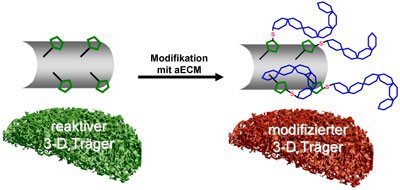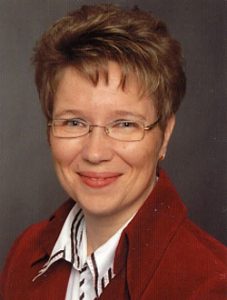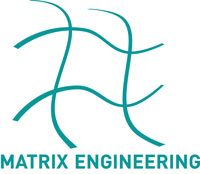
A1 – Three-dimensional ECM-Polymer hybrid matrices for in vitro und in vivo characterisation of artificial ECM-compounds (aECM)
In project A1 macromonomers will be synthesised as building blocks for the fabrication of biodegradable, cross-linked and chemically reactive carrier systems. These matrices will be modified with artificial extracellular matrix components (aECM). To this end, we propose to generate and characterise several biodegradable macromonomers with different hydrophilicity, biodegradability and chemical reactivity.
Cross-linked 2- and 3-dimensional (2-D and 3-D) polymer carrier systems will be generated from macromonomer mixtures. Through adaptation of the macromonomer composition, biodegradability, mechanic stability, reactive group density, and swelling capacity of the polymer matrices can be controlled. In addition to these physico-chemical characteristic, critical parameters such as pore size, pore structure, and porosity can be controlled during the manufacturing process of macroporous 3-D carriers (scaffolds). A series of 3-D scaffolds with varying structural and chemical properties will be fabricated and tested for scaffold mechanics, biocompatibility and biodegradability. Based on these experiments, a set of 3-D matrices will be identified which appear most suitable for the in vitro and in vivo wound healing models that will be used by our Transregio partners.
In the next phase, the 3-D scaffolds will be chemically modified with promising aECM molecules identified and provided by partner projects. The resulting hybrid systems will then be characterised physico-chemically and in cell culture tests with a special focus on biocompatibility and interactions of the material with cell lines. For promising hybrid systems, the specific interactions with growth factors relevant for wound healing (e.g., TGF-ß1, BMP-2) will be investigated in 2-D and 3-D experiments.

Publications
- Krieghoff J, Gronbach M, Schulz-Siegmund M, Hacker MC. Biodegradable macromers for implant bulk and surface engineering. Biological Chemistry, vol. 402, no. 11, 2021, pp. 1357-1374. https://doi.org/10.1515/hsz-2021-0161.
- Krieghoff J, Kascholke C, Loth R, Starke A, Koenig A, Schulz-Siegmund M, Hacker MC. Composition-controlled degradation behavior of macroporous scaffolds from three-armed biodegradable macromers. Polymer Degradation and Stability 2021. https://doi.org/10.1016/j.polymdegradstab.2021.109775.
- Nawaz HA, Schröck K, Schmid M, Krieghoff J, Maqsood I, Kascholke C, Kohn-Polster C, Schulz-Siegmund M, Hacker MC. Injectable oligomer-cross-linked gelatine hydrogels via anhydride-amine-conjugation. Journal of Materials Chemistry B 2021; 9, 2295-2307, https://doi.org/10.1039/D0TB02861D.
- Krieghoff J, Rost J, Kohn-Polster C, Müller B, Koenig A, Flath T, Schulz-Siegmund M, Schulze FP, Hacker M. Extrusion-Printing of Multi-Channeled Two-Component Hydrogel Constructs from Gelatinous Peptides and Anhydride-Containing Oligomers. Biomedicines 2021, 9, 370, doi:10.3390/biomedicines9040370.
- Gronbach M, Mitrach F, Lidzba V, Müller B, Möller S, Rother S, Salbach-Hirsch J, Hofbauer LC, Schnabelrauch M, Hintze V, Hacker MC, Schulz-Siegmund M. Scavenging of Dickkopf-1 by macromer-based biomaterials covalently decorated with sulfated hyaluronan displays pro-osteogenic effects. Acta Biomater. 2020 Sep 15;114:76-89. doi: 10.1016/j.actbio.2020.07.017. Epub 2020 Jul 13. PMID: 32673749.
- Krieghoff J, Picke AK, Salbach-Hirsch J, Rother S, Heinemann C, Bernhardt R, Kascholke C, Möller S, Rauner M, Schnabelrauch M, Hintze V, Scharnweber D, Schulz-Siegmund M, Hacker MC, Hofbauer LC, Hofbauer C. Increased pore size of scaffolds improves coating efficiency with sulfated hyaluronan and mineralization capacity of osteoblasts. Biomater Res. 2019; 23:26. doi: 10.1186/s40824-019-0172-z.
- Kascholke C, Loth T, Kohn-Polster C, Möller S, Bellstedt P, Schulz-Siegmund M, Schnabelrauch M, Hacker M. Dual-functional hydrazide-reactive and anhydride containing oligomeric hydrogel building blocks. Biomacromolecules. 2017, 18:683-694.
- Kohn-Polster C, Bhatmagar D, Woloszyn DJ, Richtmyer M, Strake A, Springwald AH, Franz S, Schulz-Siegmund M, Kaplan HM, Kohn J, Hacker MC. Dual-Component Gelatinous Peptide/Reactive Oligomer Formulations as Conduit Material and Luminal Filler for Peripheral Nerve Regeneration. Int J Mol Sci. 2017 May 21;18(5).
- Müller BM, Loth R, Hoffmeister PG, Zühl F, Kalbitzer L, Hacker MC, Schulz-Siegmund M. Surface modification of copolymerized films from three-armed biodegradable macromers – an analytical platform for modified tissue engineering scaffolds. Acta Biomater. 2017, 51:148-160.
- Sülflow K, Schneider M, Loth T, Kascholke C, Schulz-Siegmund M, Hacker MC, Simon JC, Savkovic V. Melanocytes from the outer root sheath of human hair and epidermal melanocytes display improved melanotic features in the niche provided by cGEL, oligomer-cross-linked gelatin-based hydrogel. J Biomed Mater Res A. 2016;104:3115-26.
- Picke AK, Salbach-Hirsch J, Hintze V, Rother S, Rauner M, Kascholke C, Möller S, Bernhardt R, Rammelt S, Pisabarro MT, Ruiz-Gómez G, Schnabelrauch M, Schulz-Siegmund M, Hacker MC, Scharnweber D, Hofbauer C, Hofbauer LC. Sulfated hyaluronan improves bone regeneration of diabetic rats by binding sclerostin and enhancing osteoblast function. Biomaterials. 2016;96:11-23.
- Sedaghati B, Jahroomishirazi R, Starke A, Hacker MC, Schulz-Siegmund M. Rat osteosarcoma cells as a therapeutic target model for osteoregeneration via sclerostin knockdown. Cells Tissues Organs. 2016;201:366-79.
- Hendrikx S, Kascholke C, Flath T, Schumann D, Gressenbuch M, Schulze FP, Hacker MC, Schulz-Siegmund M. Indirect rapid prototyping of sol-gel hybrid glass scaffolds for bone regen-eration – Effects of organic crosslinker valence, content and molecular weight on mechanical properties. Acta Biomater. 2016;5:318-29.
- Loth R, Loth T, Schwabe K, Bernhardt R, Schulz-Siegmund M, Hacker MC. Highly adjustable biomaterial networks from three-armed biodegradable macromers. Acta Biomater. 2015;26:82-96.
- Loth T, Hötzel R, Kascholke C, Anderegg U, Schulz-Siegmund M, Hacker MC. Gelatin-based biomaterial engineering with anhydride-containing oligomeric cross-linkers. Biomacromoleculares 2014, 15, 2104-2118
- van der Smissen A, Hoffmeister PG, Friedrich N, Watarai A, Hacker MC, Schulz-Siegmund M, Anderegg U. Artificial extracellular matrices support cell growth and matrix synthesis of hu-man dermal fibroblasts in macroporous 3D scaffolds. J Tissue Eng Regen Med. 2015;25:56-75.
- Steinhagen M, Hoffmeister PG, Nordsieck K, Hötzel R, Baumann L, Hacker MC, Schulz-Siegmund M, Beck-Sickinger AG. Matrix metalloproteinase 9 (MMP-9) mediated release of MMP-9 resistant stromal cell-derived factor 1? (SDF-1?) from surface modified polymer films. ACS Appl Mater Interfaces. 2014;6:5891-9.
- Schneider H, Sedaghati B, Naumann A, Hacker MC, Schulz-Siegmund M. Gene silencing of chordin improves BMP-2 effects on osteogenic differentiation of human adipose tissue-derived stromal cells. Tissue Eng Part A. 2014;20:335-45.
- Loth T, Hennig R, Kascholke C, Hötzel R, Hacker MC. Reactive and stimuli-responsive maleic anhydride containing macromers – multi-functional cross-linkers and building blocks for hydrogel fabrication. React Funct Polym. 2013;73:1480-92.
- Schneider H, Sedaghati B, Naumann A, Hacker MC, Schulz-Siegmund M. Gene silencing of chordin improves BMP-2 effects on osteogenic differentiation of human adipose tissue derived stromal cells. Tissue Eng Part A. 2013.
- Loth T, Hennig R, Kascholke C, Hötzel R, Hacker MC. Reactive and stimuli-responsive maleic anhydride containing macromers – multi-functional cross-linkers and building blocks for hydrogel fabrication. React.Func.Polym. 2013;008,002
- Penk A, Förster Y, Scheidt HA, Nimptsch A, Hacker M, Schulz-Siegmund M, Ahnert P, Schiller J, Rammelt S, Huster D. The pore size of PLGA bone implants determines the de novo formation of bone tissue in tibial head defects in rats. Magn Resonan Med. 2013;70:925-35.
- Hassert R, Hoffmeister PG, Pagel M, Hacker M, Schulz-Siegmund M, Beck-Sickinger AG. On-resin synthesis of an acylated and fluorescence-labeled cyclic integrin ligand for modification of poly-(lactid-coglycolic-acid). Chem Biodivers. 2012;9:2648-58.
- Ambrosch K, Manhardt M, Loth T, Bernhardt R, Schulz-Siegmund M, Hacker MC. Open porous microscaffolds for cellular and tissue engineering by lipid templating. Acta Biomaterialia. 2012; 8. 1303-15.
- Hoyer J, Schatzschneider U, Schulz-Siegmund M, Neundorf I. Dimerization of a cell-penetrating peptide leads to enhanced cellular uptake and drug delivery. Beilstein J Org Chem. 2012;8:1788-97.
- Böhme J, Anderegg U, Nimptsch A, Nimptsch K, Hacker M, Schulz-Siegmund M, Huster D, Schiller J. De novo biosynthesis of GAG in the extracellular matrix of skin studied by MALDI MS. Anal Biochem. 2012;421:791-3.
- Weber F, Böhme J, Scheidt HA, Gründer W, Rammelt S, Hacker M, Schulz-Siegmund M, Huster D. 31P and 13C solid state NMR spectroscopy to study collagen synthesis and biomineralization in polymer-based bone implants. NMR Biomed. 2012;25:464-75.
- Klouda L, Hacker MC, Kretlow JD, Mikos AG. Cytocompatibility evaluation of amphiphilic, thermally responsive and chemically crosslinkable macromers for in situ forming hydrogels. Biomaterials. 2009;30:4558-66.
- Hacker MC, Klouda L, Ma BB, Kretlow JD, Mikos AG. Synthesis and characterization of injectable, thermally and chemically gelable, amphiphilic poly(N-isopropylacrylamide)-based macromers. Biomacromolecules. 2008;9:1558-70.
- Hacker M, Ringhofer M, Appel B, Neubauer M, Vogel T, Young S, Mikos AG, Blunk T, Gopferich A, Schulz MB. Solid lipid templating of macroporous tissue engineering scaffolds. Biomaterials. 2007;28:3497-507.
- Lieb E, Hacker M, Tessmar J, Kunz-Schughart LA, Fiedler J, Dahmen C, Hersel U, Kessler H, Schulz MB, Gopferich A. Mediating specific cell adhesion to low-adhesive diblock copolymers by instant modification with cyclic RGD peptides. Biomaterials.2005;26:2333-41.
- Lieb E, Milz S, Vogel T, Hacker M, Dauner M, Schulz MB. Effects of transforming growth factor beta1 on bonelike tissue formation in three-dimensional cell culture. I. Culture conditions and tissue formation. Tissue Eng. 2004;10:1399-413.
- Lieb E, Tessmar J, Hacker M, Fischbach C, Rose D, Blunk T, Mikos AG, Gopferich A, Schulz MB. Poly(D,L-lactic acid)-poly(ethylene glycol)-monomethyl ether diblock copolymers control adhesion and osteoblastic differentiation of marrow stromal cells. Tissue Eng. 2003;9:71-84.
- Hacker M, Tessmar J, Neubauer M, Blaimer A, Blunk T, Gopferich A, Schulz MB. Towards biomimetic scaffolds: anhydrous scaffold fabrication from biodegradable amine-reactive diblock copolymers. Biomaterials.2003;24:4459-73.
Contact

Prof. Dr. rer.nat. Michaela Schulz-Siegmund
Professorship of Pharmaceutical Technology
Faculty of Medicine of Leipzig University
Institute for Pharmacy
Eilenburger Straße 15 A, 04317 Leipzig
Phone: +49 (0)341 97-36600
E-Mail: schulz@rz.uni-leipzig.de
Web: pharmazie.medizin.uni-leipzig.de

Jun.-Prof. Dr. rer.nat. habil. Michael Hacker
Pharmaceutical Technology
Faculty of Medicine of Leipzig University
Institute for Pharmacy
Eilenburger Straße 15 A, 04317 Leipzig
Phone: +49 (0)341 97-36602
E-Mail: mhacker@uni-leipzig.de
Web: pharmazie.medizin.uni-leipzig.de
and
Institute for Pharmaceutical Technology and Biopharmacy
Heinrich Heine University Düsseldorf
Faculty of Mathematics and Natural Sciences
Universitätsstraße 1
40225 Düsseldorf
Web: pharmazie.hhu.de
